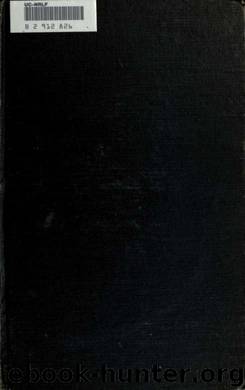Chemical studies of American barleys and malts by Le Clerc Joseph Arthur 1873- & United States. Bureau of Chemistry & Wahl Robert b. 1858

Author:Le Clerc, Joseph Arthur, 1873- & United States. Bureau of Chemistry & Wahl, Robert, b. 1858
Language: eng
Format: epub
Tags: Barley, Malt
Publisher: Washington, D.C. : Government
Published: 1909-03-25T05:00:00+00:00
with a steely endosperm, those that are mealy, and those that are partly steely and partly mealy, or intermediate.
The character of the endosperm after steeping was determined as follows:
Fifty grams of barley were steeped in water at from 15° to 20° C. for twenty-four hours. The water was then poured off and the excess removed from the grains by means of blotting pai)er. The barley was dried in a drying oven at 30° C. with low draft until the weight approximated slightly less than the original amount taken, about 49 grams. The cutting was done in the same manner as described above.
The germinating energy is represented by the i^ercentage of grains germinated within three days at ordinary temperatures. The germinating capacity is expressed as the percentage of grains which germinated in five days. These tests were made by the ordinary methods for testing germination. The weight per bushel was found by weigfiing a miniature bushel.
The degree of dissolution was determined by Prior's method:
Steep the barley in distilled water for twenty-four hours at 15° C, drain off the water, removing the excess of moisture by means of filter paper, and dry at 40° C. in an air bath for about two days; then determine the mellowness by means of Kickelhayn's apparatus. Prior considers the mealy grains which are originally present better than the modified steely grains, and therefore he adds them to the percentage of steely grains modified.
(Ma —M) 100 -^~ 100 —M '^^'
in which
A = degree of dissolution.
M = per cent of mealy kernels in original barley. Ml = per cent of mealy kernels in barley after steeping and drying.
The coefficient of mealiness in steeped and unsteeped barley was calculated according to H. T. Brown's« formula: Mealy grains are given a value of 100, half mealy 50, and steely 1. The number of grains of each type multiplied by its special value and the sum divided by 100 will give the coefficient of mealiness.
The 1,000 kernel weight is found by counting 500 kernels at random and weighing them on a technical balance. The average of four w^eighings was taken, unless the difference between the highest and lowest Aveight of 500 kernels exceeded 0.5 gram, when five or six weighings were taken.
DISCUSSION OF RESULTS.
In discussing the results obtained attention will first be called to the composition of the ordinary 6-row barleys (Table I), the Man-churian and Oderbrucker, calculated to a water-free basis, and then to the change in composition which barleys undergo on being converted into malts. Of the S-t samples of 6-row barleys, the avera.Qfe
« Loc. cit.
Download
This site does not store any files on its server. We only index and link to content provided by other sites. Please contact the content providers to delete copyright contents if any and email us, we'll remove relevant links or contents immediately.
The Vikings: Conquering England, France, and Ireland by Wernick Robert(79201)
Ali Pasha, Lion of Ioannina by Eugenia Russell & Eugenia Russell(39934)
The Vikings: Discoverers of a New World by Wernick Robert(36828)
The Conquerors (The Winning of America Series Book 3) by Eckert Allan W(36714)
Cecilia; Or, Memoirs of an Heiress — Volume 1 by Fanny Burney(32082)
Cecilia; Or, Memoirs of an Heiress — Volume 3 by Fanny Burney(31474)
Cecilia; Or, Memoirs of an Heiress — Volume 2 by Fanny Burney(31429)
Empire of the Sikhs by Patwant Singh(22778)
Hans Sturm: A Soldier's Odyssey on the Eastern Front by Gordon Williamson(18336)
The Secret History by Donna Tartt(18241)
Cat's cradle by Kurt Vonnegut(14795)
Sapiens: A Brief History of Humankind by Yuval Noah Harari(14004)
Pimp by Iceberg Slim(13810)
Talking to Strangers by Malcolm Gladwell(12907)
Norse Mythology by Gaiman Neil(12869)
Leonardo da Vinci by Walter Isaacson(12826)
Underground: A Human History of the Worlds Beneath Our Feet by Will Hunt(11850)
4 3 2 1: A Novel by Paul Auster(11824)
The Radium Girls by Kate Moore(11644)
